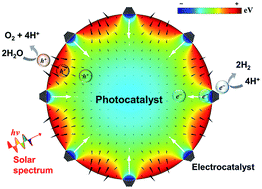A simplified theoretical guideline for overall water splitting using photocatalyst particles†
Abstract
Particulate photocatalytic water splitting is the most disruptive and competitive solution for the direct production of solar fuels. Despite more than four decades of work in the field of photocatalysis using powdered semiconductors decorated with catalyst particles, there is no clear consensus on the factors limiting the solar-to-hydrogen efficiency (STH). To understand the intrinsic limitations of the system, we numerically simulated simplified two-dimensional photocatalytic models using classical semiconductor device equations. This work presents the sensitivity of quantum efficiency (QE) to the various semiconductor properties, such as absorption properties and carrier mobilities, and to the dispersion of catalyst particles, which create heterojunctions, the driving force for charge separation. As a result, a pinch-off effect was prevalent underneath the hydrogen evolution site, suggesting an undesired energetic barrier for electron diffusion to the catalyst. The simulation using the values reported in the literature revealed that the QE was exclusively governed by recombination in the bulk of the photocatalyst particles, hindering the charge separation efficiency before reaching the catalysts on the surface. Using some of the reported parameters, our simulation shows that a typical defective n-type semiconductor particle (∼100 nm) ideally exhibits a QE of <5% in the visible light range per particle, which reaches only approximately 10% in a slurry after 4 consecutive absorbing units (1.4% STH, from simulated solar irradiation). Although the present model contains rigid limitations, we use these trends as an initial guideline to pursue photocatalysis by a design strategy, which may result in possible alternatives to achieve higher efficiencies.

- This article is part of the themed collections: Water splitting and photocatalysis and 2015 Journal of Materials Chemistry A Hot Papers

 Please wait while we load your content...
Please wait while we load your content...